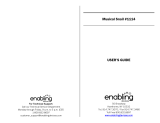
5
On the right, the yellow player
finds the nest, feather, and snail,
and moves successfully three
spaces forward. Then yellow looks
for the fried egg and cannot find
it, ending her turn.
The player‘s turn does not end
and he continues to try to cha cha
forward around the dance floor
by finding a chicken yard tile that matches the egg-shaped space in front of his
chicken on the dance floor. If a player fails his attempt to pass, his turn ends as
normal with no penalty.
Example:
Example:
Overtaking another
chicken:
GAME END AND WINNER:
If a player‘s chicken catches up
with another‘s chicken, the player
may attempt to pass the other‘s
chicken. To do so, the player must
find the chicken yard tile matching
the egg-shaped tile in front of the opponent‘s chicken. If he succeeds, his chicken
jumps in front of the other chicken and steals all that chicken’s tail feathers.
The player‘s turn does not end
and he continues to try to cha
cha forward around the dance
floor by finding a chicken yard
tile that matches the egg-
shaped space in front of his
chicken on the dance floor. If
a player fails his attempt to
pass, his turn ends as normal
with no penalty.
A chicken may pass more than
one other chicken in a jump
if they are all standing in
an unbroken line as shown in
the example, where the chicken
in back can pass both other
chickens, if the player can find
the snail.
The first chicken to collect all
the tail-feathers is the winner!
example: the blue chicken can move
three spaces if his player finds the
snail in the chicken yard.
Example:





